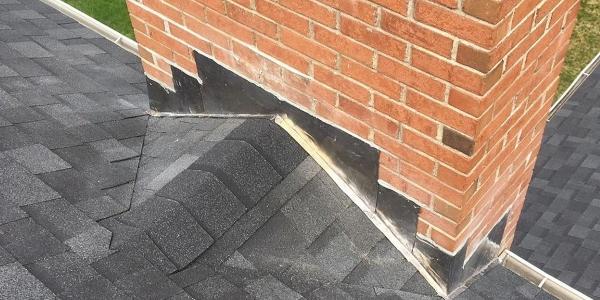Protect Every Roof Feature From Water Leaks

By IKO Industries.
Roof flashing is the best protection against water seeping into the roof deck and damaging your home. Understand why it’s important and mitigate the risk of water damage to your roof.
Roof flashing is a thin metal used to direct water away from parts of the roof, particularly where the roof plane encounters a vertical surface. Flashing surrounds roof features like chimneys, vents and skylights to help water run down to the shingles and away from the roof rather than seeping into the roof deck. One of the most common reasons for roof leaks is due to damaged roof flashing or improper installation. This article further explains the types of roof flashing, and how to properly install and repair it when needed.
Roof flashing
There are almost as many types of roof flashing as there are parts of the roof! After all, each roof feature needs protection. These are the key types of roof flashing you need to understand:
- Continuous flashing: Continuous flashing is also called apron flashing because it acts a lot like an apron. It’s a long, single piece of metal that carries water down to the shingles below. Long pieces of continuous flashing will have trouble flexing as the home expands and contracts in the changing seasons. If left as is, it could break or warp and fail to keep water out. Therefore, long pieces have built-in expansion joints so they can move with the home.
- Base flashing: Some roof features, such as chimneys, require two pieces of flashing. This ensures that rain always meets a flashing surface that directs it downwards. Plus, it is notoriously tough to install flashing around a chimney. There is another benefit to two-part flashing: When the roof materials naturally expand and contract with weather changes, the two pieces can move, so the whole system stays secure. The base flashing (or apron flashing) is the bottom piece.
- Counterflashing: Placed opposite to base flashing, or above base flashing, counterflashing completes the two-part team.
- Step flashing: Step flashing is a rectangular piece of flashing bent 90 degrees in the center. It is used for roof to wall flashing. Multiple pieces of the flashing will be installed in layers with shingles to ensure the water flows away from the wall. Learn how to install it below.
- Skylight flashing: While some skylight manufacturers include flashing in their products, sometimes roofing professionals have to create it or purchase it separately.
- Valley flashing: Open valleys have metal flashing to protect this critical area of the roof.
- Drip edges: The edge of the roof has thin metal flashing that helps water drip off the roof without damaging the home or causing a leak.
- Kickout flashing: Roofing professionals need something to bridge the gap between where step flashing ends and the gutter begins. Kickout flashing directs water away from the wall and into the gutter. Learn how to install kickout flashing below.
While there are premade flashing pieces you can purchase, many roofing professionals will cut their own roof flashing from sheet metal. They’ll use tinning snips to cut the sheets and bend them to the exact size they need while on the roof. Roof flashing materials
In the past, roofing professionals would use lead, or lead-coated materials, as flashing. However, roofing professionals in North America now prefer other materials:
- Aluminum: Aluminum flashing is easy for roofing professionals to form and is lightweight. However, aluminum must be coated if it is to be used with concrete and masonry, as plain aluminum reacts and degrades when it touches alkaline surfaces. In coastal areas, aluminum flashing should be coated even if it does not contact concrete or masonry, to prevent corrosion.
- Copper: Copper roof flashing is also malleable and takes soldering well. It’s also highly durable and has a long life. On the other hand, it does discolor into a patina, which some homeowners dislike, but others favor. You will still routinely find copper flashing around chimneys.
- Steel: Steel is usually the material of choice for flashing. It’s malleable, has aesthetic value and, when galvanized, is corrosion resistant.
Building codes may demand your roofing professional use a specific material for flashing. They may also list a minimum thickness. Most building codes require 26-gauge galvanized steel as a minimum. You should always check your local codes to be sure you’re following them.
In fact, if you live in Florida, you may find that your building codes call for a special flashing material, modified bitumen roofing tape:
- Modified bitumen roofing tape: Modified bitumen is a watertight, tough material. When made into a tape, it can be used to aid roof flashing. The specific tape you use will have to be approved by your building code and of a certain width.
Roof flashing sealant types
When your contractor installs roof flashing, you will need to use a sealant. While roofing professionals occasionally use nails when flashing, they must choose whether to nail to the roof plane or the vertical wall. If nailed to both, the flashing may deform under the pressure from shifting brick or wood. When nailed only to the roof plane or vertical wall, the flashing can stay in place while the other building materials expand and contract throughout the seasons.
- Roofing cement: Roofing cement creates a waterproof seal. Roofing professionals usually apply it with a trowel.
Roof flashing techniques
There are three primary techniques, each suitable for different areas on the roof. You’ll find that some types of flashing correspond to a specific technique.
- Step flashing: Step flashing is best for where the roof face meets a wall, for example, where a dormer projects out of the roof. In this spot, it’s possible that water could flow down the wall and slip past the shingles into the building below. Step flashing ensures that water is directed away from the wall and ends up in the gutter. It’s installed in steps, with layers of shingles between, so that the water pours down each step and down the roof.
- Counterflashing: Counterflashing is often used to flash chimneys. It involves two pieces of flashing. The first, base flashing, sits around the bottom of the chimney. The second piece, the counterflashing, is embedded into the masonry of the chimney. It sits over the base flashing to ensure water doesn’t slip behind the base flashing. Construction professionals use counterflashing for many other purposes, but it always involves a second piece of flashing set off from the first.
- Plumbing vent boot flashing: Vent flashing is a cylindrical piece of flashing that fits right around the vent. The shingles are installed over the base or boot. The height of the boot forces water to run around the vent.
[insert image 2 here]
Can you re-use old roof flashing?
On a typical re-roofing job, where you are replacing an old or underperforming roof, it is wise to replace all flashing. Old flashing may begin to fail before the new roof’s lifespan is over. However, there are limited circumstances where a roofer may decide to reuse flashing. For example, if a roofer is doing a repair job on a relatively new roof and the flashing appears to be in good condition, it may be salvaged.
To decide whether or not your flashing can be reused, your roofer will need to remove the flashing carefully to prevent damaging it. Your roofer will then inspect it before deciding to reuse it. If your roofer is replacing the shingles around your flashing, the flashing must be removed, at least temporarily, to allow for proper installation.
Some types of flashing, like step flashing, may be more challenging to reuse because it is harder to separate from the old shingles without denting or otherwise damaging it. Typically, a roofer will replace step flashing on a new roof.
Also, your roofer should not layer new flashing on top of the old flashing. You should only have one layer of flashing on a roof at a time.
When to repair a roof flashing leak
You might also wonder when you should replace roof flashing. Have a contractor check over your flashing and look for:
- Damage, holes or bending.
- Corrosion or rusting.
- Loose or missing nails.
- Dried out or missing sealant.
- Flashing that has come loose.
If a contractor finds any of these problems, you may need to replace the flashing.
You may also wonder if you’ll need to replace your flashing when you’re having a new roof installed. That depends on a few factors. If the original flashing is in good condition and can be removed without damaging it, it is possible to reuse it. However, you’ll need to prioritize proper fit and seal over saving money if you want a watertight roof; so be prepared to purchase new flashing where needed.
How to repair roof flashing
Fixing roof flashing, just like installing flashing, is best left to roofing professionals. You should not take risks with your roof.
- Step one: Gently pry up the shingles surrounding or covering the damaged flashing. When working with step flashing, this may involve removing undamaged pieces of flashing as well.
- Step two: Take your chisel and gently remove any asphalt cement you find.
- Step three: If you caught the flashing problem before a leak began, there should be no damage to the underlying roof parts and structure. However, it’s important to check for damage anyway. If you find damage, then you will have to get it repaired before reinstalling the flashing.
- Step four: Now, reinstall the new flashing and shingles. Be sure to follow the proper order, as described above, especially when installing step flashing, to ensure the flashing will stand up to water.
Though roof flashing isn’t the most dramatic element of a roof, it is one of the most important. If you find some flashing on your roof that you’re concerned about, we suggest you find a professional roofer. A professional can help you solve all of your roof flashing problems or answer the questions you have about your specific roof.
Original article source: IKO Industries
Have a question? AskARoofer.
Find your local roofing contractor in the RoofersCoffeeShop® Contractor Directory.










Comments
Leave a Reply
Have an account? Login to leave a comment!
Sign In